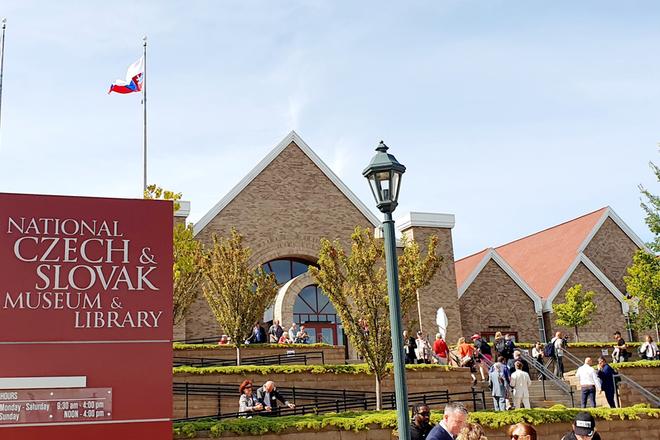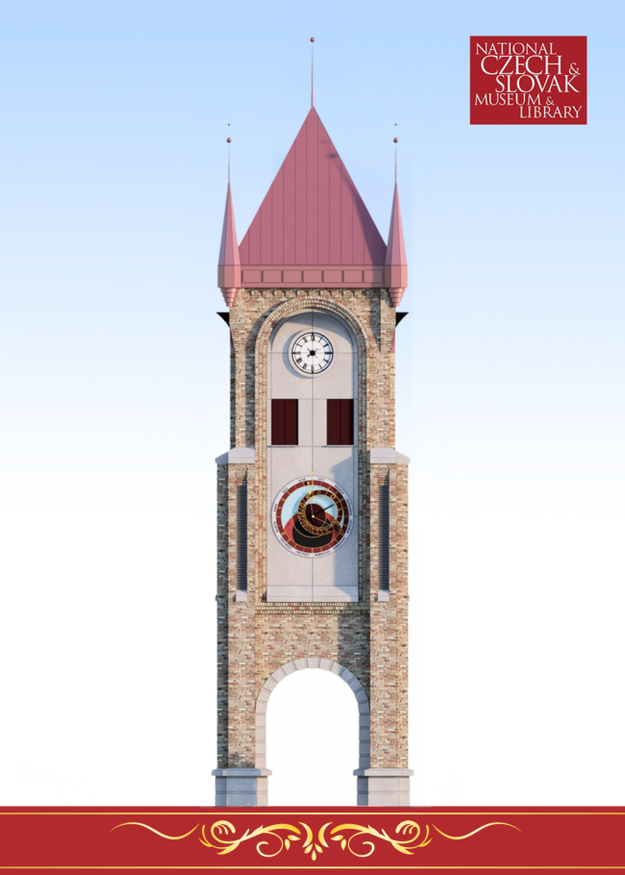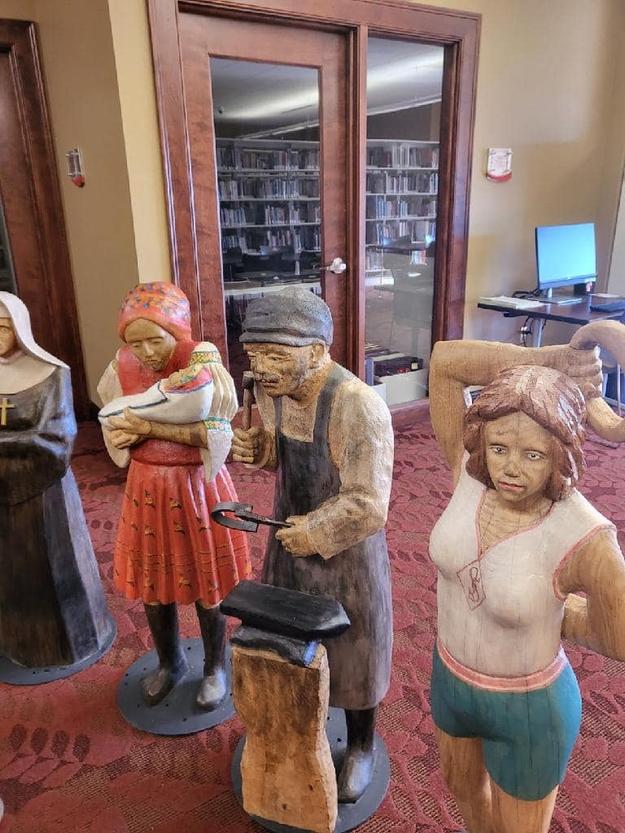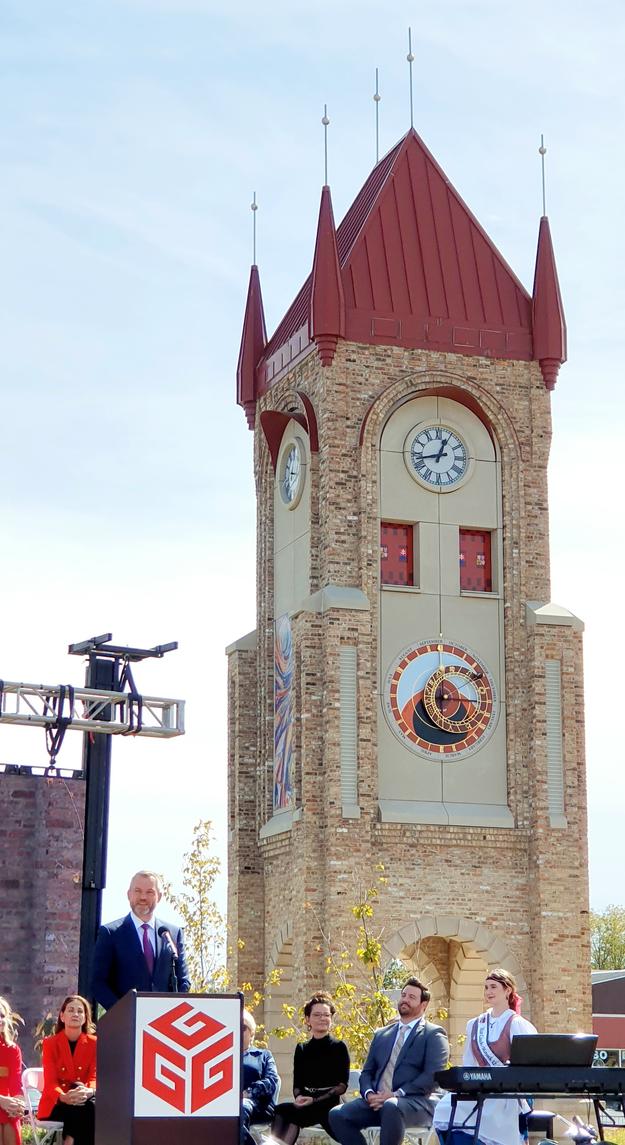Mark Dillon, a fourth-generation Slovak-American and author, is chair of the Board of Directors of the Czechoslovak Genealogical Society International.
When Martin Izakovic came to the United States in 1911, he worked in the Pittsburgh area before returning to his Slovak village three years later.
Andrej Haršány, a descendant of Izakovic’s 21st-century extended family, hopes to make a more lasting impact on America as the National Czech & Slovak Museum & Library (NCSML) in the U.S. state of Iowa has recently unveiled a new €1.5 million Orloj astronomical clock tower that depicts the Slovak and Czech emigration story.
The 40-year-old Borová artist has hand-sculpted a dozen 1.2-metre-tall immigrant figurines for the clock. They include a Roman Catholic nun, a miner, a meatcutter, a farmer, a Sokol acrobat, a blacksmith, an ice delivery man, a concertina musician, a woman in Moravian kroj (traditional folk costume - Ed.), a dancing couple, a banker and a mother with an infant.
Starting on September 27, Haršány’s 12 hand-painted figurines, highlighting 19th and early 20th-century immigration, will emerge at the top of each hour from the 18.6-metre-tall tower. In pairs, they will rotate as a nearly 1,900-kilogram Prague-crafted clock mechanism plays the music of Czech composers Antonín Dvořák and Bedřich Smetana. Each figurine cost around €18,000.
“Each one is symbolic,” Haršány said of the figurines in an online interview. “Each came with a specific design plan. Each has a story.”
Dual Slovak & Czech presidential visits
The U.S. event drew both Slovak President Peter Pellegrini and Czech Republic President Peter Pavel, marking a highlight of the museum’s 50th anniversary year, an institution that began as a local Czech-focused Fine Arts Foundation in 1974.
Haršány’s habit-clad nun figurine, the miner with a face blackened to resemble coal dust, and the mother and child, all feature Slovak characteristics. Meanwhile, the farmer’s attire is typical of early 20th-century Nebraska, still the U.S.' most Czech state by percentage of population. Haršány’s meatcutter wields a butcher’s knife, evoking memories of Chicago and Kansas City, home to beef stockyards and meatpacking factories once staffed by Slovak and Czech immigrants a century ago.
The intent, says Dalibor Mikulas, a native Slovak and NCSML’s Vice President and Chief Operating Officer, is to showcase the contributions and aspirations of immigrants to the U.S.’s growth and diversity, drawing on the unique experiences of Slovaks and Czechs, with design input from project donors. Most donors’ ancestors first arrived in the mid-19th century.
This romantic realism in art is a departure from Haršány’s impressionistic style in stone, as seen in exhibits throughout Slovakia. For instance, in Bratislava last year, Haršány teamed up with painter Tomáš Žemla at the White & Weiss Gallery to create Earth Song, an exhibition focusing on humanity’s exploitation of nature and its environmental impact.
“Most of my art is abstract. These figurines are realistic, unique, and were wonderful to work on in my village studio.” The white oak used for the figurines was sourced from a wooded area a few kilometres from Haršány’s home, he says. Commissioned in March, Haršány completed the project this summer, and it arrived in America a few weeks before the event.
The astronomical clock’s digital components were built in the Czech Republic by the SPEL Company in Prague, the caretaker of the 15th-century Prague Orloj, built in 1410. Smetana’s music calls people to gather three minutes before the hour, from 9:00 until 22:00, while Dvořák’s New World Symphony will play as Haršány’s figurines appear.
Among the 200 invited guests were Haršány’s Slovak-American relatives from Mount Airy in the U.S. state of North Carolina, where Haršány also has a public granite sculpture. Also attending was NCSML board member Dr. Martin Izakovic, an Iowa physician and another member of the Isakovic family tree, who encouraged Haršány to seek the figurine commission.
NCSML featuring more Slovak exhibits
Haršány’s work is the latest initiative by a now globally renowned museum to showcase Slovak and Czech culture, art, heritage, and research at NCSML, under the leadership of Dr Cecilia Rokusek, president and CEO. Rokusek also serves as Slovak honorary consul for southern Florida in the U.S.
“It is truly a Czech and Slovak effort,” Rokusek says of the project. The Orloj replaces a clock tower damaged by a straight-line windstorm four years ago. Three decades earlier, in October 1995, the original tower was co-dedicated by Slovak President Michal Kováč, Czech President Václav Havel, and U.S. President Bill Clinton.
On the evening before the clock tower debut, Pellegrini also dedicated the NCSML’s incorporation of the Jankola Library into its research collection, named after Slovak-American Roman Catholic priest Rev Matthew Jankola. Meanwhile, Pavel brought around 60 guests on his presidential jet, according to the museum.
Pellegrini was also scheduled to meet with Slovak-American leaders for 45 minutes after the Orloj dedication for a forum discussion, followed by a one-hour public “political roundtable” with Pavel and various diplomats.
Until this spring, the Sisters of Saints Cyril and Methodius, an order of nuns founded by Slovak-American Rev Jankola, managed the library on their campus in Danville, Pennsylvania. Since the mid-1940s, the library has amassed one of the largest collections of Slovak and diaspora literature, history, language, spiritual works, and science holdings in North America.
The Iowa museum’s tower and collection expansion are seen by benefactors as positive affirmations of an era when more than 500,000 Slovaks emigrated to the U.S. in search of new lives, overcoming a lack of opportunity and discrimination in the Austro-Hungarian Empire. In Slovak lands, one in every five people emigrated to the U.S. between 1880 and the mid-1920s, according to the U.S. genealogy group CGSI.
The tower is named the Buresh Immigration Clock Tower, after the late Ernie Buresh, a Czech-American banker and longtime NCSML donor who contributed $250,000 USD towards the Orloj upgrade.
100 years since immigration restricted
The Orloj dedication also coincides with the 100th anniversary of the Johnson-Reed Act, national U.S. legislation that severely restricted immigration from Central and Eastern Europe, limiting the number of immigrants from Czechoslovakia to 3,073 persons a year. (At the time, Czechoslovakia included Czechia, Slovakia, and the Carpatho-Rusyn homeland region surrounding Uzhhorod, now part of Ukraine.)
Overcoming adversity to retell the immigration story is something the NCSML knows well. In 2008, flooding of the Cedar River adjacent to the museum caused $11 million worth of damage and led the museum to relocate its main building to higher ground. The 2020 windstorm provided an insurance settlement that helped catalyse the clock tower rebuilding and expansion plan to create a functional Orloj and figurines, which were not part of the original tower.
Additional work on the four-sided tower, still in progress, includes one side featuring a stone angel, with reliefs focusing on immigration to Iowa. A Moravian artist is creating two temporary art panels—one representing Czech culture and the other Slovak culture. With further fundraising, the museum hopes to install bronze sculptures depicting immigration to replace the art panels. A sundial will also be added to the fourth side, facing the street.
Iowa can experience extreme weather, including an average of 48 tornadoes per year, with powerful winds and hail. The region receives about a metre of snow each winter, and average daily temperatures are below freezing from December to February.
Haršány arrived in Iowa on September 15 to help install the figurines with the assistance of a construction crew and museum volunteers, and he hopes his woodwork can withstand the test of time and climate change.
“We’ve done everything we can to protect them,” he noted.

 The National Czech & Slovak Museum & Library in Iowa. (source: TASR - Jaroslav Bublinec)
The National Czech & Slovak Museum & Library in Iowa. (source: TASR - Jaroslav Bublinec)
 The Orloj clock tower. (source: NCSML)
The Orloj clock tower. (source: NCSML)
 Andrej Haršány, a Slovak artist, has hand-sculpted a dozen 1.2 metre tall immigrant figurines for the Orloj clock in Iowa. (source: Mark Dillon)
Andrej Haršány, a Slovak artist, has hand-sculpted a dozen 1.2 metre tall immigrant figurines for the Orloj clock in Iowa. (source: Mark Dillon)
 President Peter Pellegrini, together with Czech President Petr Pavel, officially launched the new Orloj on the renovated tower at the National Czech & Slovak Museum and Library in Cedar Rapids, Iowa, on September 27. (source: TASR - Jaroslav Bublinec)
President Peter Pellegrini, together with Czech President Petr Pavel, officially launched the new Orloj on the renovated tower at the National Czech & Slovak Museum and Library in Cedar Rapids, Iowa, on September 27. (source: TASR - Jaroslav Bublinec)